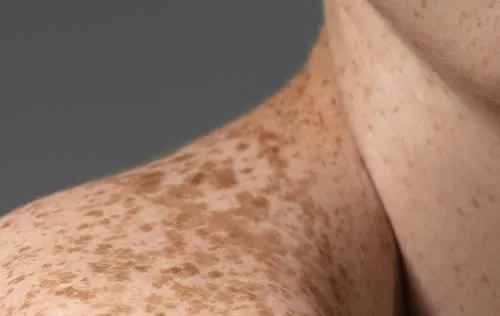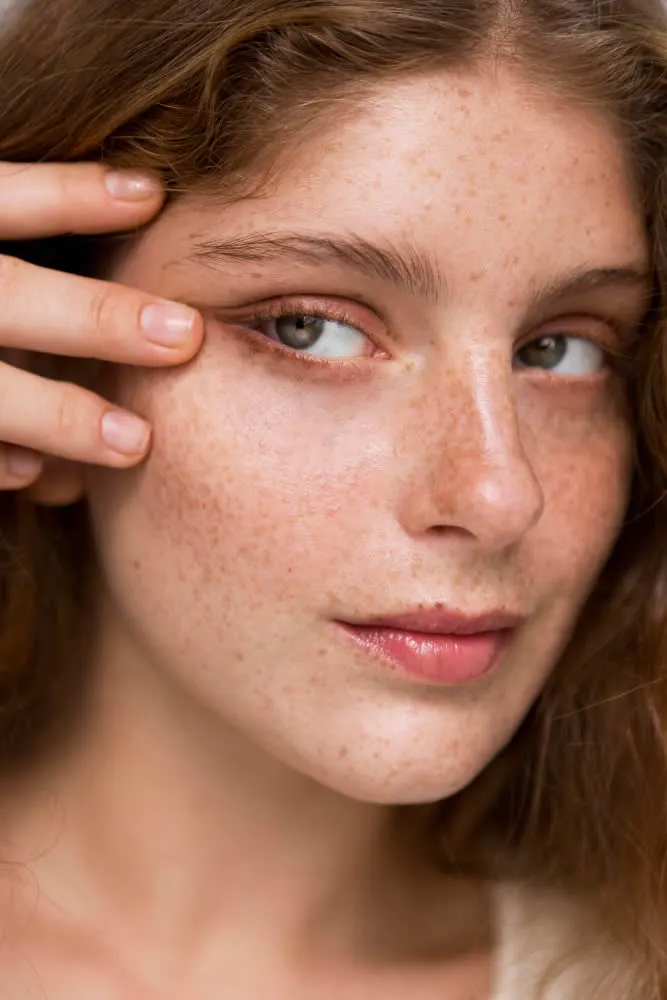What are Freckles?
Freckles are small, flat, circular spots on the skin that are usually tan or light brown in color. They are most commonly found on the face, arms, and shoulders, and are more common in people with fair skin. Freckles are caused by the overproduction of melanin, which is the pigment that gives skin its color. When the skin is exposed to sunlight, the melanocytes (cells that produce melanin) in the skin produce more melanin in an attempt to protect the skin from UV radiation. This results in the formation of freckles. Freckles are generally harmless and do not require treatment, although people who are concerned about their appearance may choose to use makeup or other cosmetic products to cover them up. It is important to remember that freckles are a natural part of the skin and do not pose any health risks.

Causes and Genetics of Freckles
Freckles are charming clusters of pigment on the skin that often capture attention. To understand why these adorable spots appear, it’s essential to delve into the causes and genetics that contribute to their development.
Sun Exposure and Melanin:
The primary catalyst for the emergence of freckles is sun exposure. When your skin is exposed to ultraviolet (UV) rays from the sun, it triggers the production of melanin. Melanin is the pigment responsible for giving color to your skin, hair, and eyes. Freckles develop when certain skin cells, known as melanocytes, produce an excess amount of melanin in response to UV radiation.
Genetic Predisposition:
Genetics play a pivotal role in whether you’re prone to freckles or not. If your parents or close relatives have freckles, there’s a higher likelihood that you might develop them too. The presence of freckles is associated with specific genetic variations that influence how your skin responds to UV exposure and how melanin is produced and distributed.
MC1R Gene:
One of the key players in freckle formation is the MC1R gene, which is involved in producing a protein responsible for regulating melanin production. Variants of this gene can lead to a heightened sensitivity to UV radiation, making individuals more susceptible to freckles when exposed to sunlight.
Fair Skin and Freckles:
People with fair skin tend to have a higher risk of developing freckles. Fair skin contains less melanin to begin with, making it more vulnerable to the sun’s effects. While freckles can appear on individuals of all skin types, they’re particularly noticeable on lighter skin due to the contrast in color.
Beyond Genetics:
Although genetics are a key factor, other elements also contribute to freckle development. Hormonal changes, such as those during pregnancy, can lead to an increase in melanin production, potentially causing freckles to become more pronounced.
Treating Freckles
While freckles are generally harmless and do not require treatment, some people may choose to reduce their appearance for cosmetic reasons. There are several treatments available that may help to lighten or remove freckles, including:
- Skin-lightening creams: These creams contain ingredients that can help to lighten the skin and reduce the appearance of freckles. They may contain ingredients such as hydroquinone, kojic acid, or glycolic acid.
- Chemical peels: Chemical peels involve applying a chemical solution to the skin, which causes the top layer of skin to peel off. This can help to reduce the appearance of freckles and other skin discolorations.
- Laser therapy: Laser therapy uses focused light energy to break up the melanin pigment in the skin, which can help to lighten freckles and other skin discolorations.
- Cryosurgery: This involves freezing the freckles with liquid nitrogen, which causes the top layer of skin to peel off. This can help to reduce the appearance of freckles.
When to See a Dermatologist for Freckles
While most freckles don’t pose a medical concern, there are instances when consulting a dermatologist is recommended to ensure your skin’s health and appearance. DrName at PracticeName in CityName is here to provide expert guidance and personalized care for your skin needs.
Indications for Seeking Dermatological Evaluation:
- Unusual Changes in Freckles: If you notice any sudden changes in the size, color, shape, or texture of your freckles, it’s important to have them evaluated by a dermatologist. Changes could potentially indicate more serious skin conditions.
- New or Atypical Freckles: Any new freckles that develop after adolescence or freckles that stand out due to their irregular borders or dark color should be examined by a dermatologist.
- Pain or Irritation: Freckles should not cause discomfort. If you experience pain, itching, or any form of irritation in or around your freckles, it’s best to have a professional assessment.
- Rapid Growth: Freckles that show rapid growth over a short period of time may require medical attention to rule out underlying issues.
- Family History of Skin Cancer: If you have a family history of skin cancer or are at a higher risk due to genetic factors, it’s wise to schedule regular skin check-ups with a dermatologist.
- Concerns about Skin Cancer: Freckles can sometimes resemble certain types of skin cancer. If you have concerns about the possibility of skin cancer, a dermatologist can perform a thorough examination and offer peace of mind or recommend further testing.

Myths and Facts about Freckles
Freckles have long been a subject of fascination and speculation. However, it’s important to distinguish between myths and facts when it comes to understanding these small, pigmented spots on the skin. Let’s delve into some common myths and separate them from the realities about freckles:
Myth: Freckles are a Sign of Unhealthy Skin
Fact: Freckles are generally harmless and not indicative of unhealthy skin. They are primarily caused by genetics and sun exposure, rather than underlying health issues. While it’s crucial to monitor any changes in your skin, having freckles itself does not necessarily indicate a skin problem.
Myth: Freckles Are Always Permanent
Fact: Freckles can fade over time, especially when sun exposure is reduced or proper sun protection is maintained. With diligent care and protection, some freckles may become less prominent or even disappear over the years.
Myth: Freckles Can Turn into Skin Cancer
Fact: The majority of freckles are harmless and pose no risk of turning into skin cancer. However, it’s essential to differentiate between freckles and other skin lesions. If you notice any changes in size, shape, color, or texture, it’s advisable to consult a dermatologist for a professional evaluation.
Myth: Freckles Only Develop in Fair-Skinned Individuals
Fact: While freckles are more commonly seen in individuals with fair skin, they can develop in people with various skin tones. The pigment-producing cells responsible for freckles are present in all skin types, although they might be more pronounced in lighter skin.
Myth: Freckles Can Be Prevented Completely
Fact: While you can take steps to reduce the likelihood of freckles, such as using sunscreen and seeking shade, complete prevention may not always be possible. Genetics play a significant role in determining whether you’ll develop freckles, so even with diligent sun protection, you might still develop them to some extent.
Myth: Freckles Only Develop on Exposed Skin
Fact: Freckles typically develop on areas exposed to the sun, like the face, arms, and shoulders. However, they can appear on less-exposed areas as well. Genetics and sun exposure patterns influence where freckles emerge.
Myth: Removing Freckles Is Always Necessary
Fact: Freckles are a natural aspect of skin pigmentation and don’t require removal for health reasons. If you choose to address their appearance, treatments like laser therapy or chemical peels can help lighten or reduce their visibility, but they might not be necessary for everyone.
Separating fact from fiction is crucial when it comes to understanding freckles. If you have concerns about your freckles or other skin-related matters, consult DrName at PracticeName in CityName. With their expertise in dermatology, they can provide personalized guidance and recommend appropriate treatments based on your needs.
FAQ About Freckles
Can Freckles be removed?
While Freckles are generally harmless and do not require treatment, some people may choose to reduce their appearance for cosmetic reasons. There are several treatments available that may help to lighten or remove freckles, including skin-lightening creams, chemical peels, laser therapy, and cryosurgery.
Are Freckles more common in certain ethnicities?
Freckles are more common in people with fair skin, particularly those of European descent. However, people of any ethnicity can have freckles.
Can Freckles be a result of medication?
Yes, certain medications such as birth control pills and some antibiotics can cause freckles or make existing freckles more pronounced.
Are there different types of Freckles?
Yes, there are two types of Freckles: ephelides and solar lentigines. Ephelides are usually small and light brown, and they tend to appear on areas of the skin that are exposed to the sun. Solar lentigines are larger and darker than ephelides, and they tend to appear on areas of the skin that have received a lot of sun exposure over time.
Do Freckles only appear on the face?
Freckles can appear on any area of the skin that is exposed to the sun, including the face, arms, legs, and chest. However, they are most commonly seen on the face.
Is there a dermatologist near me in St. Petersburg that offers treatment for Freckles?
Yes. At our St. Petersburg dermatology office we offer treatment for Freckles to patients from St. Petersburg and the surrounding area. Contact our office today to schedule an appointment.

